Experimental–Simulation Analysis of a Radiation Tolerant Erbium-Doped Fiber Amplifier for Space Applications
Abstract
:1. Introduction
2. Simulation and Experimental Procedure
2.1. Tested Optical Fiber and Amplifier
2.2. Theoretical Model
2.3. Spectroscopic Characterization
2.4. RIA Measurements
2.5. Gain Degradation Measurements
3. Results
3.1. 4I13/2 Energy Level Lifetime
3.2. Absorption and Emission Cross Sections
3.3. RIA Measurements Results
3.4. Gain Degradation Measurements Results
4. Discussion
5. Conclusions
Author Contributions
Funding
Institutional Review Board Statement
Informed Consent Statement
Data Availability Statement
Conflicts of Interest
Abbreviations
| AlOHC | Al-oxygen hole center |
| ASE | Amplified spontaneous emission |
| EDF | Erbium-doped fiber |
| EDFA | Erbium-doped fiber amplifier |
| FUT | Fiber under test |
| PB | Photobleaching |
| PSO | Particle swarm optimization |
| RE | Rare earth |
| REDF | Rare-earth-doped fiber |
| REDFA | Rare-earth-doped fiber amplifier |
| REDFS | Rare-earth-doped fiber source |
| RIA | Radiation-induced attenuation |
| RIE | Radiation-induced emission |
| RIC | Radiation-induced compaction |
| TID | Total ionizing dose |
| TRL | Time-resolved luminescence |
| WDM | Wavelength division multiplexing |
References
- Giles, C.R.; Desurvire, E. Modeling erbium-doped fiber amplifiers. J. Light. Technol. 1991, 9, 271–283. [Google Scholar] [CrossRef]
- Delavaux, J.-M.P.; Nagel, J.A. Multi-stage erbium-doped fiber amplifier designs. J. Light. Technol. 1995, 13, 703–720. [Google Scholar] [CrossRef]
- Wright, M.W.; Valley, G.C. Yb-Doped Fiber Amplifier for Deep-Space Optical Communications. J. Light. Technol. 2005, 23, 1369–1374. [Google Scholar] [CrossRef]
- Lefevre, H.C. The Fiber-Optic Gyroscope, 2nd ed.; Artech House: Norwood, MA, USA, 2014. [Google Scholar]
- Falconi, M.C.; Laneve, D.; Portosi, V.; Taccheo, S.; Prudenzano, F. Design of a Multi-Wavelength Fiber Laser Based on Tm:Er:Yb:Ho Co-Doped Germanate Glass. J. Light. Technol. 2020, 38, 2406–2413. [Google Scholar] [CrossRef]
- Falconi, M.C.; Loconsole, A.M.; Prudenzano, F. Modeling of rare-earth-doped glass devices and optical parameter indirect evaluation. Opt. Mater. 2022, 132, 112835. [Google Scholar] [CrossRef]
- Liu, C.; Wu, X.; Zhu, J.; He, N.; Li, Z.; Zhang, G.; Zhang, L.; Ruan, S. Radiation-Resistant Er3+-Doped Superfluorescent Fiber Sources. Sensors 2018, 18, 2236. [Google Scholar] [CrossRef] [PubMed]
- Janvier, P.-O.; Matte-Breton, C.; Monga, K.J.-J.; Wang, L.; Rusch, L.; LaRochelle, S. Optimization criteria and design of few-mode Erbium-doped fibers for cladding-pumped amplifiers. Opt. Express 2023, 31, 14888–14902. [Google Scholar] [CrossRef] [PubMed]
- Girard, S.; Morana, A.; Ladaci, A.; Thierry, R.; Mescia, L.; Bonnefois, J.-J.; Boutillier, M.; Mekki, J.; Paveau, A.; Cadier, B.; et al. Recent advances in radiation hardened fiber-based technologies for space applications. J. Opt. 2018, 20, 093001. [Google Scholar] [CrossRef]
- Dakin, J.P.; Brown, R.G.W. Handbook of Optoelectronics: Applied Optical Electronics; CRC Press: Boca Raton, FL, USA, 2018; Volume 3, pp. 409–427. [Google Scholar]
- Barrera, D.; Madrigal, J.; Delepine-Lesoille, S.; Salvador, S. Multicore optical fiber shape sensors suitable for use under gamma radiation. Opt. Express 2019, 27, 29026–29033. [Google Scholar] [CrossRef]
- Cheymol, G.; Verneuil, A.; Grange, P.; Maskrot, H.; Destouches, C. High-Temperature Measurements with a Fabry–Perot Extensometer. IEEE Trans. Nucl. Sci. 2020, 67, 552–558. [Google Scholar] [CrossRef]
- Campanella, C.; Mescia, L.; Bia, P.; Chiapperino, M.; Girard, S.; Robin, T.; Mekki, J.; Boukenter, A.; Ouerdane, Y. Theoretical Investigation of Thermal Effects in High Power Er3+/Yb3+—Codoped Double-Clad Fiber Amplifiers for Space Applications. Phys. Status Solidi A 2019, 216, 1800582. [Google Scholar] [CrossRef]
- Yan, B.; Liu, H.; Liu, B.; Liu, J.; Zhang, H.; Yang, C.; Hu, Z.; Li, X. EDFA Anti-Irradiation Schemes for Inter-Satellite Optical DPSK Communication Systems. IEEE Photonics J. 2019, 11, 4900711. [Google Scholar] [CrossRef]
- Jiao, Y.; Guo, M.T.; Wang, R.L.; Shao, C.Y.; Hu, L.L. Influence of Al/Er ratio on the optical properties and structures of Er3+/Al3+ co-doped silica glasses. J. Appl. Phys. 2021, 129, 053104. [Google Scholar] [CrossRef]
- Ainslie, B.J. A review of the fabrication and properties of erbium-doped fibers for optical amplifiers. J. Light. Technol. 1991, 9, 220–227. [Google Scholar] [CrossRef]
- Shikama, T.; Kakuta, T.; Shamoto, N.; Narui, M.; Sagawa, T. Behavior of developed radiation-resistant silica-core optical fibers under fission reactor irradiation. Fusion Eng. Des. 2000, 51–52, 179–183. [Google Scholar] [CrossRef]
- Wijnands, T.; Aikawa, K.; Kuhnhenn, J.; Ricci, D.; Weinand, U. Radiation Tolerant Optical Fibers: From Sample Testing to Large Series Production. J. Light. Technol. 2011, 29, 3393–3400. [Google Scholar] [CrossRef]
- Gencheng, W.; She, S.; Zhang, Y.; Wang, Y.; Li, M.; Ma, Z.; Zhang, Y.; Gao, S.; Cui, X.; Li, Z.; et al. Hydrogen-Related Anti-Radiation Effect and Its Suppression Mechanism in Er3+/Al3+/Ge4+ Co-Doped Silica Fibers. J. Light. Technol. 2023, 41, 6073–6080. [Google Scholar] [CrossRef]
- Jiao, Y.; Yang, Q.; Zhu, Y.; Wang, F.; Zhang, L.; Meng, M.; Wang, S.; Shao, C.; Yu, C.; Hu, L. Improved radiation resistance of an Er-doped silica fiber by a preform pretreatment method. Opt. Express 2022, 30, 6236–6247. [Google Scholar] [CrossRef]
- Zhu, Y.; Shao, C.; Wang, F.; Wang, M.; Zhang, L.; Dai, Y.; Yu, C.; Hu, L. Improved Radiation Resistance of Er-Yb Co-Doped Silica Fiber by Pretreating Fibers. Photonics 2023, 10, 414. [Google Scholar] [CrossRef]
- Vivona, M.; Girard, S.; Marcandella, C.; Robin, T.; Cadier, B.; Cannas, M.; Boukenter, A.; Ouerdane, Y. Influence of Ce codoping and H2 pre-loading on Er/Yb-doped fiber: Radiation response characterized by Confocal Micro-Luminescence. J. Non-Cryst. Solid 2010, 357, 1963–1965. [Google Scholar] [CrossRef]
- Vivona, M.; Girard, S.; Robin, T.; Cadier, B.; Vacarro, L.; Cannas, M.; Boukenter, A.; Ouerdane, Y. Influence of Ce3+ Codoping on the Photoluminescence Excitation Channels of Phosphosilicate Yb/Er-Doped Glasses. IEEE Photonics Technol. Lett. 2012, 24, 509–511. [Google Scholar] [CrossRef]
- Girard, S.; Alessi, A.; Richard, N.; Martin-Samos, L.; De Michele, V.; Giacomazzi, L.; Agnello, S.; Di Francesca, D.; Morana, A.; Winkler, B.; et al. Overview of radiation induced point defects in silica-based optical fibers. Rev. Phys. 2019, 4, 100032. [Google Scholar] [CrossRef]
- Campanella, C.; De Michele, V.; Morana, A.; Guttilla, A.; Mady, F.; Benabdesselam, M.; Marin, E.; Boukenter, A.; Ouerdane, Y.; Girard, S. Temperature Dependence of Radiation Induced Attenuation of Aluminosilicate Optical Fiber. IEEE Trans. Nucl. Sci. 2022, 69, 1515–1520. [Google Scholar] [CrossRef]
- Zotov, K.V.; Likhachev, M.E.; Tomashuk, A.L.; Kosolapov, A.F.; Bubnov, M.M.; Yashkov, M.V.; Guryanov, A.N.; Dianov, E.M. Radiation Resistant Er-Doped Fibers: Optimization of Pump Wavelength. IEEE Photonics Technol. Lett. 2008, 20, 1476–1478. [Google Scholar] [CrossRef]
- Kenworthy, A.K. Photobleaching FRET microscopy. In Molecular Imaging; American Physiological Society: Rockville, MD, USA, 2005; pp. 146–164. [Google Scholar] [CrossRef]
- Aubry, M.; Mescia, L.; Morana, A.; Robin, T.; Arnaud, L.; Mekki, J.; Marin, E.; Ouerdane, Y.; Girard, S.; Boukenter, A. Temperature Influence on the Radiation Responses of Erbium-Doped Fiber Amplifiers. Phys. Status Solidi (A) 2021, 218, 2100002. [Google Scholar] [CrossRef]
- Ladaci, A.; Girard, S.; Mescia, L.; Robin, T.; Laurent, A.; Cadier, B.; Boutillier, M.; Morana, A.; Di Francesca, D.; Ouerdane, Y.; et al. X-rays, γ-rays, electrons and protons radiation-induced changes on the lifetimes of Er3+ and Yb3+ ions in silica-based optical fibers. J. Lumin. 2017, 195, 402–407. [Google Scholar] [CrossRef]
- Miniscalco, W.J. Erbium doped glasses for fiber amplifiers at 1550 nm. J. Light. Technol. 1991, 9, 234. [Google Scholar] [CrossRef]
- Pukhkaya, V.; Goldner, P.; Ferrier, A.; Ollier, N. Impact of rare earth element clusters on the excited state lifetime evolution under irradiation in oxide glasses. Opt. Express 2015, 23, 3270–3281. [Google Scholar] [CrossRef]
- Ollie, R.N.; Doualan, J.-L.; Pukhkaya, V.; Charpentier, T.; Moncorgé, R.; Sabyasachi, S. Evolution of Yb3+ environment and luminescence properties under ionizing irradiation in aluminoborosilicate glasses. J. Non-Cryst. Solids 2011, 357, 1037–1043. [Google Scholar] [CrossRef]
- Mescia, L.; Girard, S.; Bia, P.; Robin, T.; Laurent, A.; Prudenzano, F.; Boukenter, A.; Ouerdane, Y. Optimization of the Design of High Power Er3+/Yb3+-Codoped Fiber Amplifiers for Space Missions by Means of Particle Swarm Approach. IEEE J. Sel. Top. Quantum Electron. 2014, 20, 100108. [Google Scholar] [CrossRef]
- Giaquinto, A.; Mescia, L.; Fornarelli, G.; Prudenzano, F. Particle swarm optimization-based approach for accurate evaluation of upconversion parameters in Er3+-doped fibers. Opt. Lett. 2011, 36, 142–144. [Google Scholar] [CrossRef] [PubMed]
- Ladaci, A.; Girard, S.; Mescia, L.; Robin, T.; Laurent, A.; Cadier, B.; Boutillier, M.; Ouerdane, Y.; Boukenter, A. Optimized radiation-hardened erbium doped fiber amplifiers for long space missions. J. Appl. Phys. 2017, 121, 163104. [Google Scholar] [CrossRef]
- Mescia, L.; Bia, P.; Girard, S.; Ladaci, A.; Chiapperino, M.; Thierry, R.; Laurent, A.; Cadier, B.; Boutillier, M.; Ouerdane, Y.; et al. Temperature-Dependent Modeling of Cladding-Pumped Er3+/Yb3+—Codoped Fiber Amplifiers for Space Applications. J. Light. Technol. 2018, 36, 3594–3602. [Google Scholar] [CrossRef]
- Tao, M.; Chen, H.; Feng, G.; Luan, K.; Wang, F.; Huang, K.; Xisheng, Y. Thermal modeling of high-power Yb-doped fiber lasers with irradiated active fibers. Opt. Express 2020, 28, 10104–10123. [Google Scholar] [CrossRef]
- Ladaci, A.; Girard, S.; Mescia, L.; Robin, T.; Cadier, B.; Laurent, A.; Boutillier, M.; Sane, B.; Marin, E.; Ouerdane, Y.; et al. Validity of the McCumber Theory at High Temperatures in Erbium and Ytterbium-Doped Aluminosilicate Fibers. IEEE J. Quantum Electron. 2018, 54, 7000207. [Google Scholar] [CrossRef]
- Roderick, L.J. Spectroscopy of Rare Earth Doped Glasses. Ph.D. Thesis, Faculty of Science, University of Southampton, Southampton, UK, 1992; p. 218. [Google Scholar]
- Kitazawa, M. POF Data Book; MRC Techno Research Inc.: Tokyo, Japan, 1993; p. 37. [Google Scholar]
- Rose, T.; Gunn, D.; Valley, G. Gamma and proton radiation effects in erbium-doped fiber amplifiers: Active and passive measurements. J. Light. Technol. 2001, 19, 1918–1923. [Google Scholar] [CrossRef]
- Zotov, K.V.; Likhachev, M.E.; Tomashuk, A.L.; Bubnov, M.M.; Yashkov, M.V.; Guryanov, A.N.; Klyamkin, S.N. Radiation-Resistant Erbium-Doped Fiber for Spacecraft Applications. IEEE Trans. Nucl. Sci. 2008, 55, 2213–2215. [Google Scholar] [CrossRef]
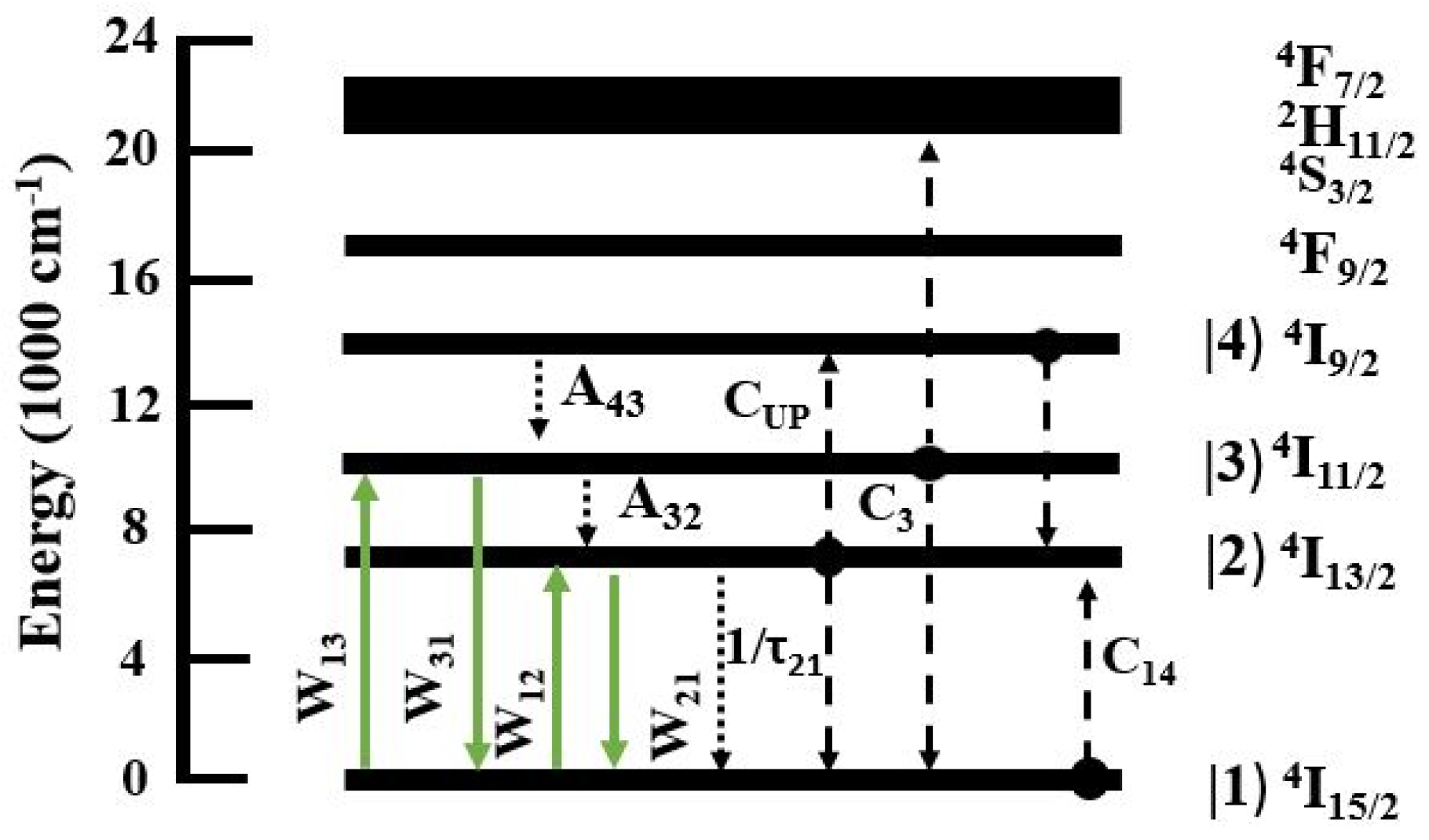


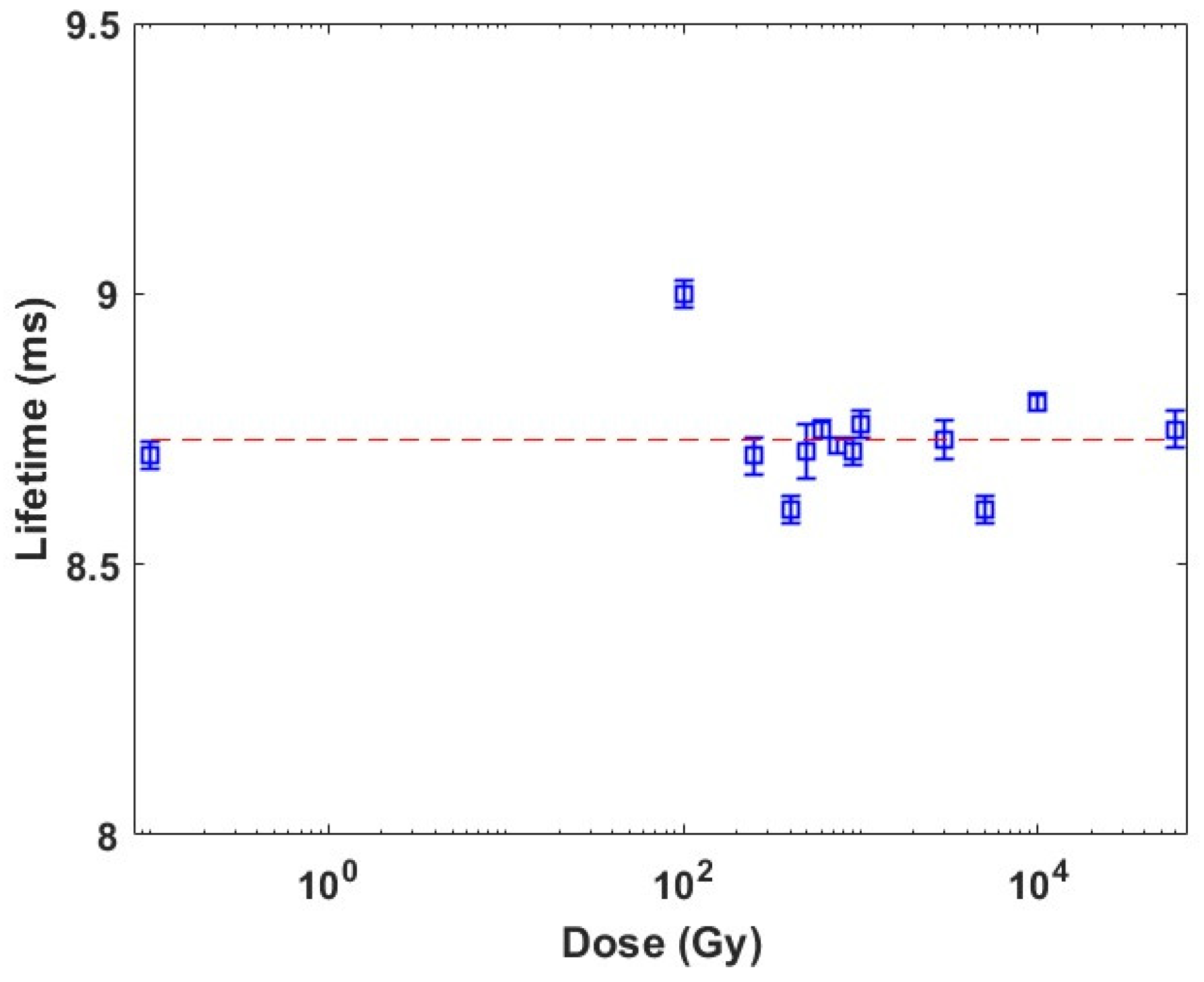


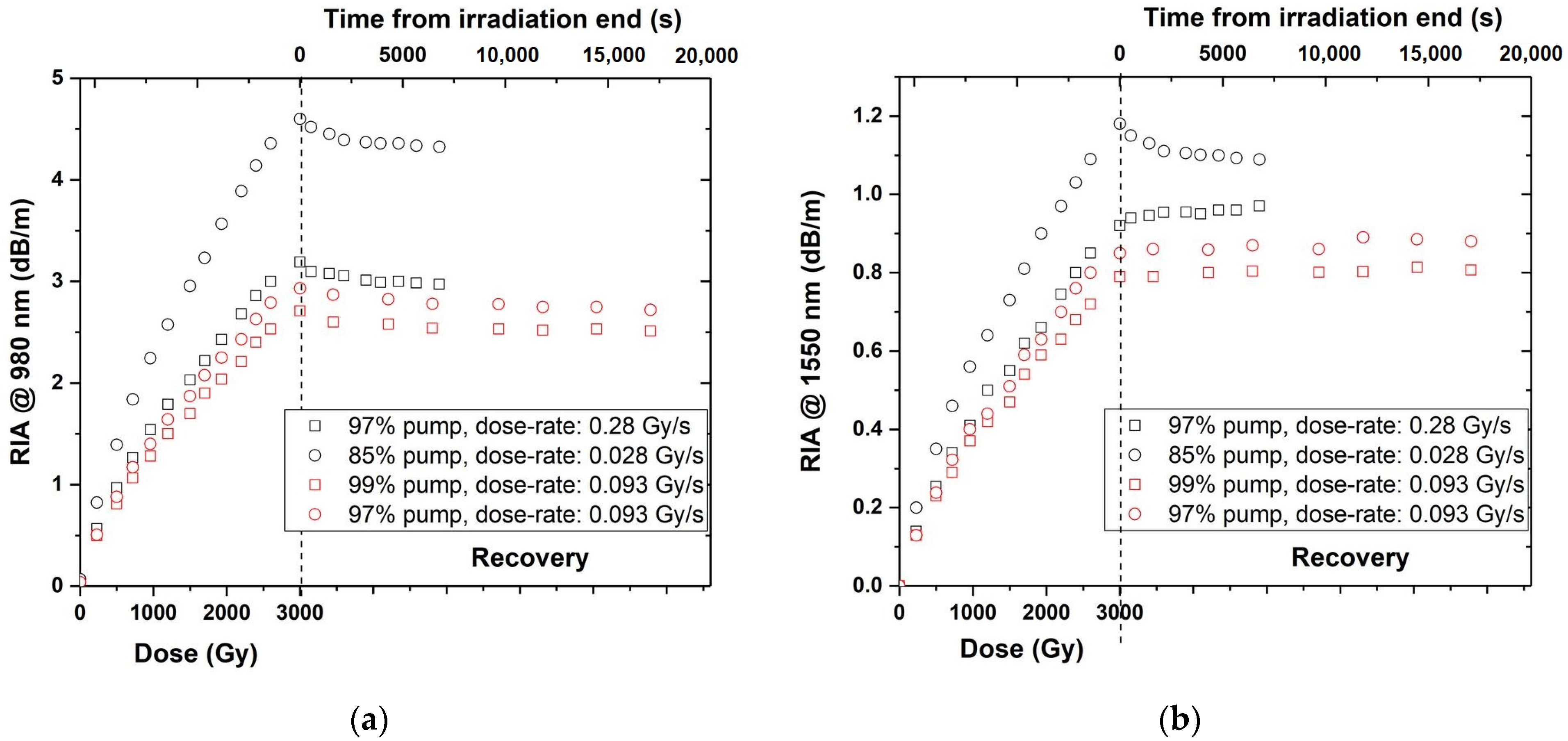
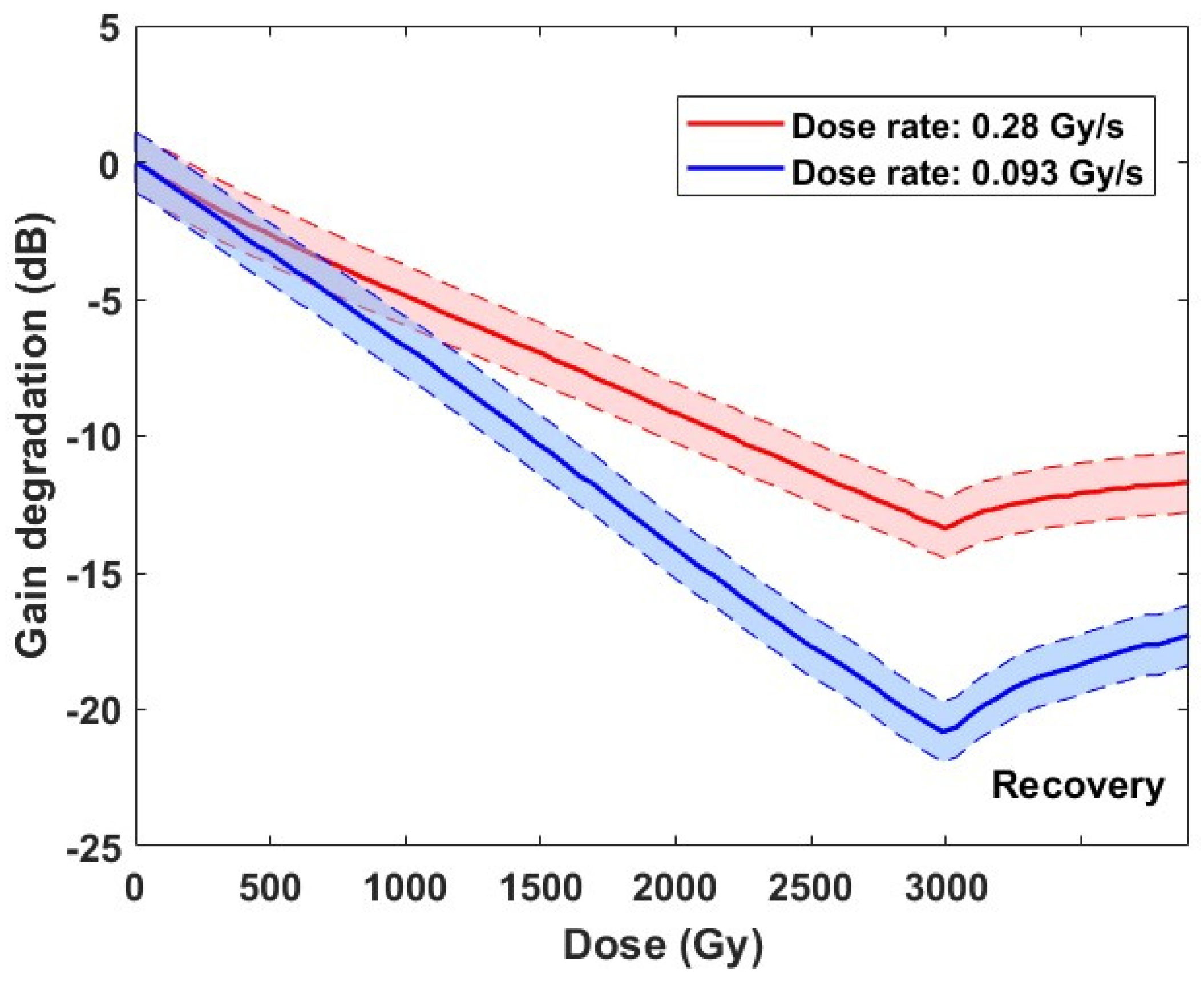
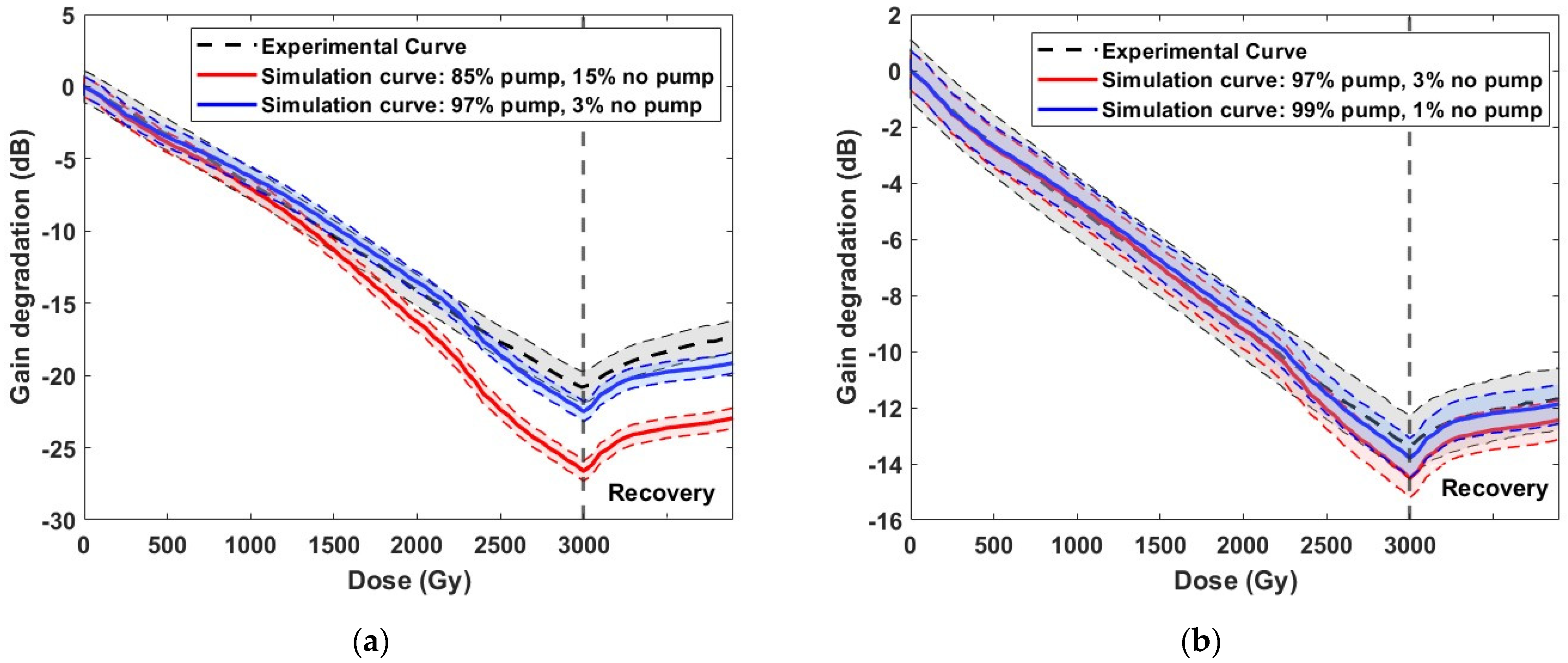
| Core/Cladding Diameter | Erbium Ions Concentration | Losses @1530 nm | Losses @980 nm | Background Losses | Core Dopants |
|---|---|---|---|---|---|
| 2.8 µm/127 µm | 1.21 × 1019 ions/cm3 | 24 dB/m | 14 dB/m | 6.2 dB/km | Al-Er-Ce |
| Fiber Length | Signal–Pump Configuration | Signal Power at 1550 nm | Pump Power at 980 nm |
|---|---|---|---|
| 4.3 m | Co-propagating | 1 µW | 50 mW |
| Spectroscopic Parameter | Value |
|---|---|
| 4I13/2 Lifetime τ21 | 8.72 ms (□) |
| 4I11/2 Lifetime τ32 | 10 µs [23] |
| 4I9/2 Lifetime τ43 | 0.1 µs [23] |
| σ12 Er3+ @1530 nm | 8.8 × 10−25 m2 (□) |
| σ21 Er3+ @1530 nm | 9.3 × 10−25 m2 (□) |
| σ13 Er3+ @980 nm | 6 × 10−25 m2 (□) |
| σ31 Er3+ @980 nm | 0.007 × 10−25 m2 (□) |
| Cup | 4 × 10−24 m3/s [23] |
| C3 | 1.09 × 10−24 m3/s [23] |
| C14 | 6.4 × 10−23 m3/s [23] |
| RIA Measurement | Dose Rate | Percentage of Pump Time | Percentage of No Pump Time |
|---|---|---|---|
| #1 | 0.28 Gy/s (SiO2) | 85% | 15% |
| #2 | 0.28 Gy/s (SiO2) | 97% | 3% |
| #3 | 0.093 Gy/s (SiO2) | 97% | 3% |
| #4 | 0.093 Gy/s (SiO2) | 99% | 1% |
Disclaimer/Publisher’s Note: The statements, opinions and data contained in all publications are solely those of the individual author(s) and contributor(s) and not of MDPI and/or the editor(s). MDPI and/or the editor(s) disclaim responsibility for any injury to people or property resulting from any ideas, methods, instructions or products referred to in the content. |
© 2023 by the authors. Licensee MDPI, Basel, Switzerland. This article is an open access article distributed under the terms and conditions of the Creative Commons Attribution (CC BY) license (https://creativecommons.org/licenses/by/4.0/).
Share and Cite
Facchini, A.; Morana, A.; Mescia, L.; Campanella, C.; Shuvo, M.M.K.; Robin, T.; Marin, E.; Ouerdane, Y.; Boukenter, A.; Girard, S. Experimental–Simulation Analysis of a Radiation Tolerant Erbium-Doped Fiber Amplifier for Space Applications. Appl. Sci. 2023, 13, 11589. https://doi.org/10.3390/app132011589
Facchini A, Morana A, Mescia L, Campanella C, Shuvo MMK, Robin T, Marin E, Ouerdane Y, Boukenter A, Girard S. Experimental–Simulation Analysis of a Radiation Tolerant Erbium-Doped Fiber Amplifier for Space Applications. Applied Sciences. 2023; 13(20):11589. https://doi.org/10.3390/app132011589
Chicago/Turabian StyleFacchini, Alberto, Adriana Morana, Luciano Mescia, Cosimo Campanella, Md Mizan Kabir Shuvo, Thierry Robin, Emmanuel Marin, Youcef Ouerdane, Aziz Boukenter, and Sylvain Girard. 2023. "Experimental–Simulation Analysis of a Radiation Tolerant Erbium-Doped Fiber Amplifier for Space Applications" Applied Sciences 13, no. 20: 11589. https://doi.org/10.3390/app132011589
APA StyleFacchini, A., Morana, A., Mescia, L., Campanella, C., Shuvo, M. M. K., Robin, T., Marin, E., Ouerdane, Y., Boukenter, A., & Girard, S. (2023). Experimental–Simulation Analysis of a Radiation Tolerant Erbium-Doped Fiber Amplifier for Space Applications. Applied Sciences, 13(20), 11589. https://doi.org/10.3390/app132011589









